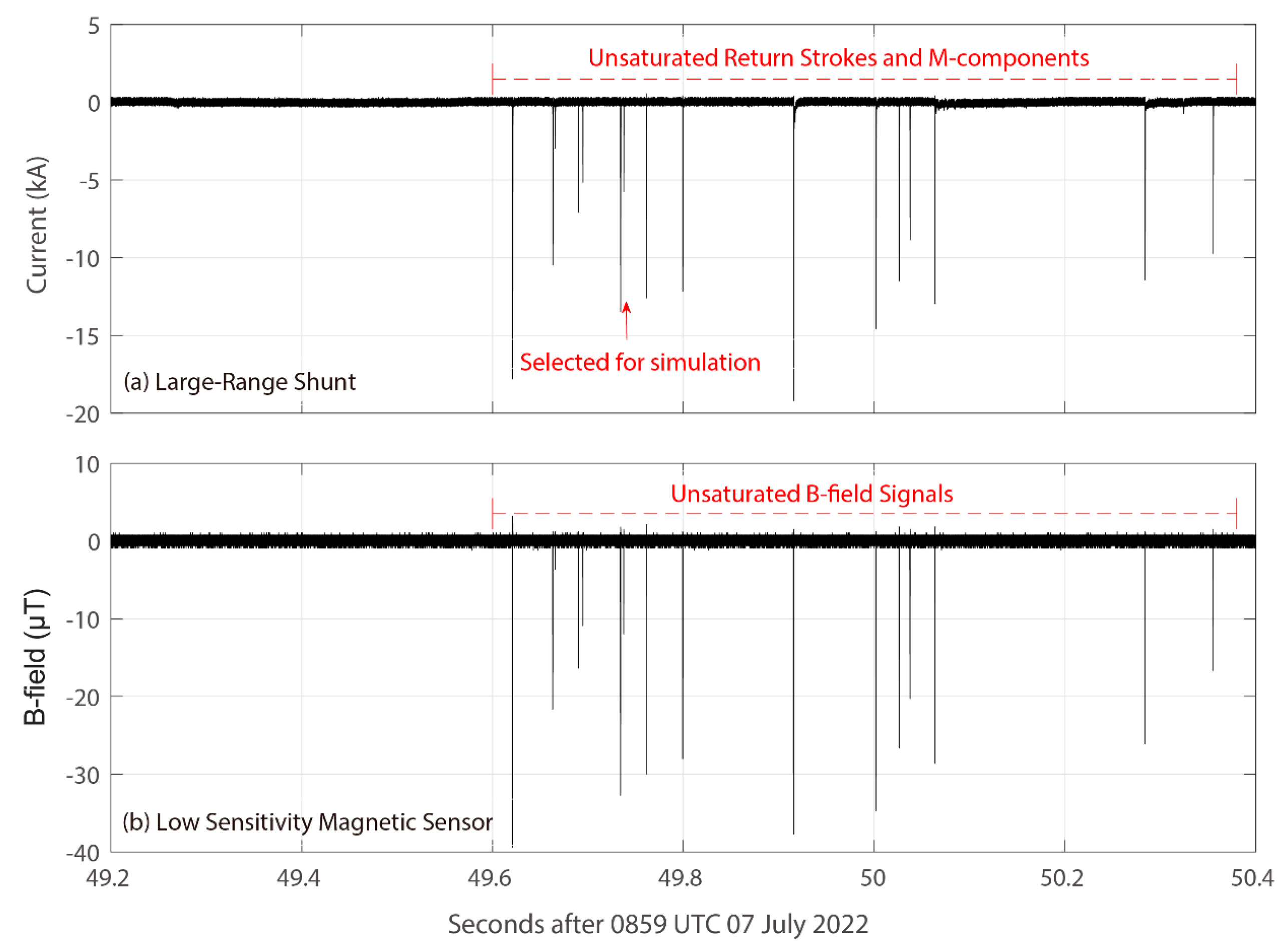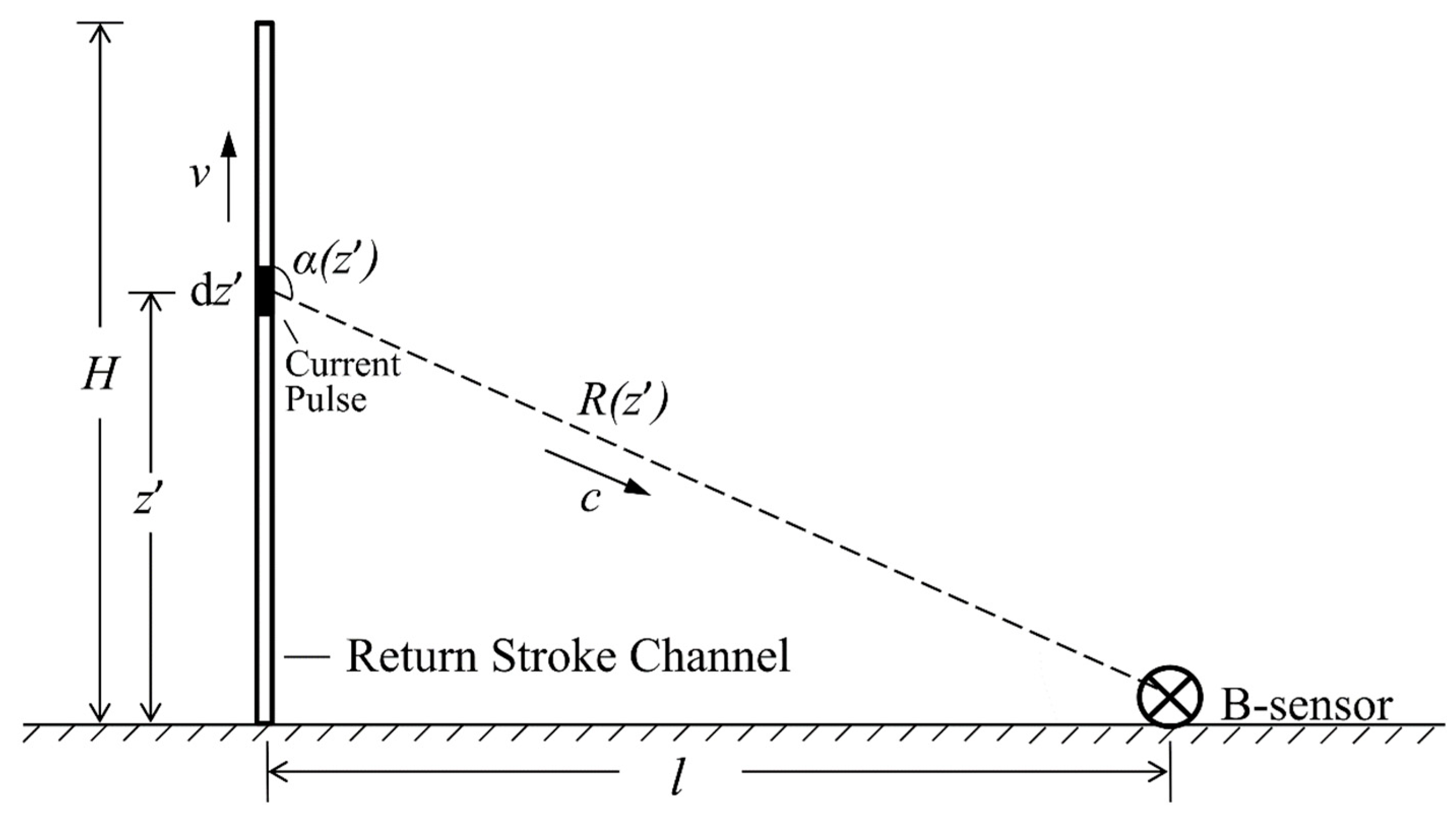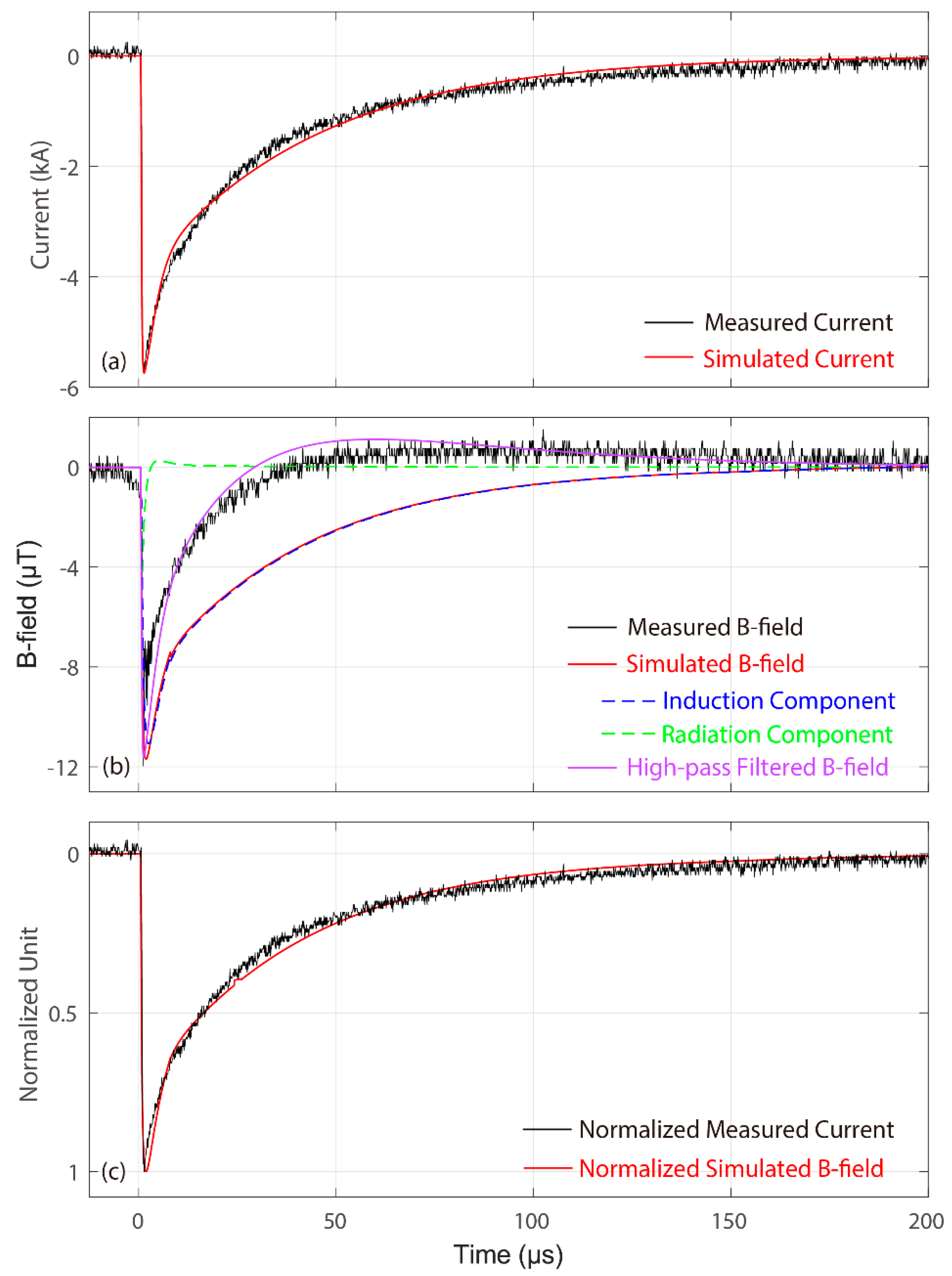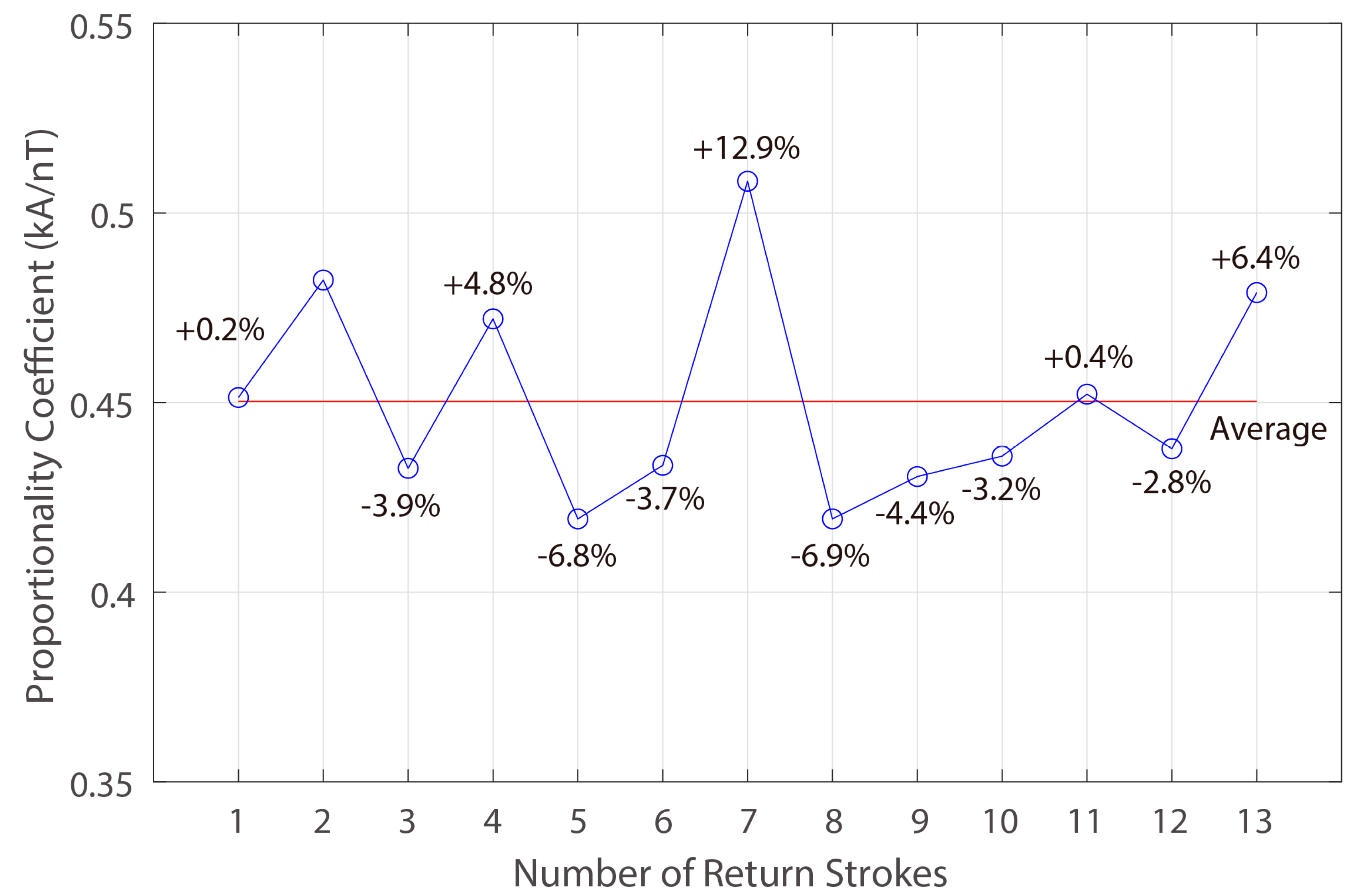Correlation between Frequency-Divided Magnetic Field and Channel-Base Current for Rocket-Triggered Lightning
Abstract
1. Introduction
2. Measurements and Data
3. Analyses and Results
3.1. Frequency Spectrum for Triggered-Lightning Discharge Processes with Different Temporal Scales and Correspondence with the Bandwidth of B-Field Antenna
3.2. Correlation between dB/dt Measurements and Initial Continuous Current
3.3. The B-Field Radiation of the Return Stroke at Close Range
4. Discussion
5. Summary
Author Contributions
Funding
Data Availability Statement
Acknowledgments
Conflicts of Interest
Abbreviations
| CMA-FEBLS | Field Experiment Base on Lightning Sciences, China Meteorological Administration |
| GCOELD | Guangdong Comprehensive Observation Experiment on Lightning Discharge |
| SHATLE | SHAndong Triggering Lightning Experiment |
| B-field | magnetic field |
| E-field | electric field |
| UPL | upward positive leader |
| ICC | initial continuous current |
| MF | medium frequency (300 kHz–3 MHz) |
| LF | low frequency (30 kHz–300 kHz) |
| VLF | very low frequency (3 kHz–30 kHz) |
| SLF | super low frequency (30 Hz–300 Hz) |
| TL | transmission line |
| MTLL | modified transmission line model with linear current decay with height |
References
- Brook, M.; Kitagawa, N.; Workman, E.J. Quantitative study of strokes and continuing currents in lightning discharges to ground. J. Geophys. Res. 1962, 67, 649–659. [Google Scholar] [CrossRef]
- Kodali, V.; Rakov, V.A.; Uman, M.A.; Rambo, K.J.; Schnetzer, G.H.; Schoene, J.; Jerauld, J. Triggered-lightning properties inferred from measured currents and very close electric fields. Atmos. Res. 2005, 76, 355–376. [Google Scholar] [CrossRef]
- DeCarlo, B.A.; Rakov, V.A.; Jerauld, J.; Schnetzer, G.H.; Schoene, J.; Uman, M.A.; Rambo, K.J.; Kodali, V.; Jordan, D.M.; Maxwell, G.; et al. Distribution of Currents in the Lightning Protective System of a Residential Building-Part I: Triggered-Lightning Experiments. IEEE Trans. Power Deliv. 2008, 23, 2439–2446. [Google Scholar] [CrossRef]
- Campos, L.Z.S.; Saba, M.M.F.; Pinto, O.; Maurício, G.B. Waveshapes of continuing currents and properties of M-components in natural positive cloud-to-ground lightning. Atmos. Res. 2009, 91, 416–424. [Google Scholar]
- Newman, M.M.; Stahmann, J.R.; Robb, J.D.; Lewis, E.A.; Martin, S.G.; Zinn, S.V. Triggered lightning strokes at very close range. J. Geophys. Res. 1967, 72, 4671–4674. [Google Scholar] [CrossRef]
- Schoene, J.; Uman, M.A.; Rakov, V.A.; Rambo, K.J.; Jerauld, J.; Mata, C.T.; Mata, A.G.; Schnetzer, G.H. Characterization of return-stroke currents in rocket-triggered lightning. J. Geophys. Res. 2009, 114, D03106. [Google Scholar] [CrossRef]
- Thottappillil, R.; Goldberg, J.D.; Rakov, V.A.; Uman, M.A.; Fisher, R.J.; Schnetzer, G.H. Properties of M-components from currents measured at triggered lightning channel base. J. Geophys. Res. 1995, 100, 25711–25720. [Google Scholar] [CrossRef]
- Fieux, R.; Gary, C.; Hubert, P. Artificially triggered lightning above land. Nature 1975, 257, 212–214. [Google Scholar] [CrossRef]
- Fisher, R.J.; Schnetzer, G.H.; Thottappillil, R.; Rakov, V.A.; Uman, M.A.; Goldberg, J.D. Parameters of triggered-lightning flashes in Florida and Alabama. J. Geophys. Res. 1993, 98, 22887–22902. [Google Scholar] [CrossRef]
- Lalande, P.; Bondiou-Clergerie, A.; Laroche, P.; Eybert-Berard, A.; Berlandis, J.-P.; Bador, B.; Bonamy, A.; Uman, M.A.; Rakov, V.A. Leader properties determined with triggered lightning techniques. J. Geophys. Res. 1998, 103, 14109–14115. [Google Scholar] [CrossRef]
- Willett, J.C.; Davis, D.A.; Laroche, P. An experimental study of positive leaders initiating rocket-triggered lightning. Atmos. Res. 1999, 51, 189–219. [Google Scholar] [CrossRef]
- Biagi, C.J.; Jordan, D.M.; Uman, M.A.; Hill, J.D.; Beasley, W.H.; Howard, J. High-speed video observations of rocket-and-wire initiated lightning. Geophys. Res. Lett. 2009, 36, L15801. [Google Scholar] [CrossRef]
- Biagi, C.J.; Uman, M.A.; Hill, J.D.; Jordan, D.M. Observations of the initial, upward-propagating, positive leader steps in a rocket-and-wire triggered lightning discharge. Geophys. Res. Lett. 2011, 38, L24809. [Google Scholar] [CrossRef]
- Wang, D.; Rakov, V.A.; Uman, M.A.; Fernandez, M.I.; Rambo, K.J.; Schnetzer, G.H.; Fisher, R.J. Characterization of the initial stage of negative rocket-triggered lightning. J. Geophys. Res. 1999, 104, 4213–4222. [Google Scholar] [CrossRef]
- Thottappillil, R.; Rakov, V.A.; Uman, M.A. Distribution of charge along the lightning channel: Relation to remote electric and magnetic fields and to return-stroke models. J. Geophys. Res. 1997, 102, 6987–7006. [Google Scholar] [CrossRef]
- Qie, X.; Zhao, Y.; Zhang, Q.; Yang, J.; Feng, G.; Kong, X.; Zhou, Y.; Zhang, T.; Zhang, G.; Zhang, T.; et al. Characteristics of triggered lightning during Shandong artificial triggering lightning experiment (SHATLE). Atmos. Res. 2009, 91, 310–315. [Google Scholar] [CrossRef]
- Jiang, R.; Qie, X.; Wang, C.; Yang, J. Propagating features of upward positive leaders in the initial stage of rocket-triggered lightning. Atmos. Res. 2013, 129, 90–96. [Google Scholar] [CrossRef]
- Fan, Y.; Lu, G.; Jiang, R.; Zhang, H.; Li, X.; Liu, M.; Qie, X.; Zheng, D.; Lyu, W.; Zhang, Y.; et al. Characteristics of electromagnetic signals during the initial stage of negative rocket-triggered lightning. J. Geophys. Res. Atmos. 2018, 123, 11625–11636. [Google Scholar] [CrossRef]
- Fan, Y.; Lu, G.; Li, X.; Zheng, T.; Zhang, H.; Jiang, R.; Liu, M.; Qie, X.; Zhang, Y.; Zhang, Y.; et al. Measurements of magnetic pulse bursts during initial continuous current of negative rocket-triggered lightning. J. Geophys. Res. Atmos. 2019, 124, 11710–11721. [Google Scholar] [CrossRef]
- Lu, G.; Fan, Y.; Zhang, H.; Jiang, R.; Liu, M.; Qie, X.; Cummer, S.A.; Han, C.; Liu, K. Measurement of continuing charge transfer in rocket-triggered lightning with low-frequency magnetic sensor at close range. J. Atoms. Sol.-Terr. Phy. 2018, 175, 76–86. [Google Scholar] [CrossRef]
- Zheng, D.; Zhang, Y.; Lu, W.; Zhang, Y.; Dong, W.; Chen, S.; Dan, J. Characteristics of return stroke currents of classical and altitude triggered lightning in GCOELD in China. Atmos. Res. 2013, 129–130, 67–68. [Google Scholar] [CrossRef]
- Zhang, Y.; Yang, S.; Lu, W.; Zheng, D.; Dong, W.; Li, B.; Chen, S.; Zhang, Y.; Chen, L. Experiments of artificially triggered lightning and its application in Conghua, Guangdong, China. Atmos. Res. 2014, 135–136, 330–343. [Google Scholar] [CrossRef]
- Rakov, V.A.; Dulzon, A. A modified transmission line model for lightning return stroke field calculations. In Proceedings of the 9th International Symposium on EMC, Zurich, Switzerland, 5–10 March 1991. [Google Scholar]
- Uman, M.A.; McLain, D.K.; Krider, E.P. The electromagnetic radiation from a finite antenna. Am. J. Phys. 1975, 43, 33–38. [Google Scholar] [CrossRef]
- Thottappillil, R.; Rakov, V.A. On different approaches to calculating lightning electric fields. J. Geophys. Res. 2001, 106, 14191–14206. [Google Scholar] [CrossRef]
- Heidler, H. Analytische Blitzstromfunktion zur LEMP-Berechnung. In Proceedings of the 18th International Conference on Lightning Protection, Munich, Germany, 16–20 September 1985. [Google Scholar]
- Rachidi, F.; Janischewskyj, W.; Hussein, A.M.; Nucci, C.A.; Guerrieri, S.; Kordi, B.; Chang, J.S. Current and electromagnetic field associated with lightning-return strokes to tall towers. IEEE Trans. Electromagn. Compat. 2001, 43, 356–367. [Google Scholar] [CrossRef]












Disclaimer/Publisher’s Note: The statements, opinions and data contained in all publications are solely those of the individual author(s) and contributor(s) and not of MDPI and/or the editor(s). MDPI and/or the editor(s) disclaim responsibility for any injury to people or property resulting from any ideas, methods, instructions or products referred to in the content. |
© 2023 by the authors. Licensee MDPI, Basel, Switzerland. This article is an open access article distributed under the terms and conditions of the Creative Commons Attribution (CC BY) license (https://creativecommons.org/licenses/by/4.0/).
Share and Cite
Fan, Y.; Zhang, Y.; Lyu, W.; Ma, Y.; Wu, B.; Qi, Q.; Zheng, D.; Lu, G.; Wu, A. Correlation between Frequency-Divided Magnetic Field and Channel-Base Current for Rocket-Triggered Lightning. Remote Sens. 2023, 15, 3902. https://doi.org/10.3390/rs15153902
Fan Y, Zhang Y, Lyu W, Ma Y, Wu B, Qi Q, Zheng D, Lu G, Wu A. Correlation between Frequency-Divided Magnetic Field and Channel-Base Current for Rocket-Triggered Lightning. Remote Sensing. 2023; 15(15):3902. https://doi.org/10.3390/rs15153902
Chicago/Turabian StyleFan, Yanfeng, Yang Zhang, Weitao Lyu, Ying Ma, Bin Wu, Qi Qi, Dong Zheng, Gaopeng Lu, and Ankun Wu. 2023. "Correlation between Frequency-Divided Magnetic Field and Channel-Base Current for Rocket-Triggered Lightning" Remote Sensing 15, no. 15: 3902. https://doi.org/10.3390/rs15153902
APA StyleFan, Y., Zhang, Y., Lyu, W., Ma, Y., Wu, B., Qi, Q., Zheng, D., Lu, G., & Wu, A. (2023). Correlation between Frequency-Divided Magnetic Field and Channel-Base Current for Rocket-Triggered Lightning. Remote Sensing, 15(15), 3902. https://doi.org/10.3390/rs15153902




